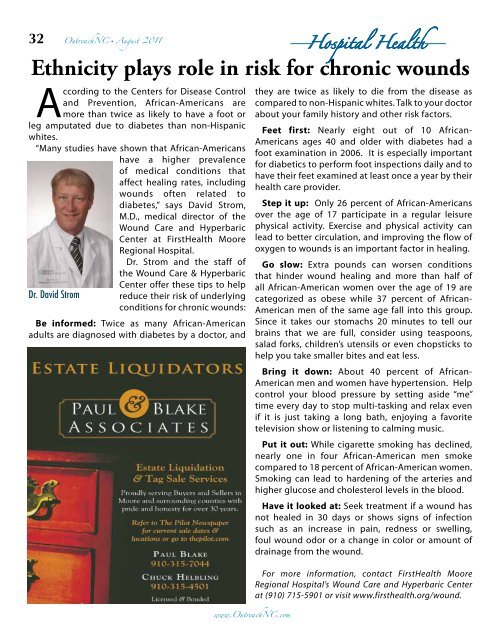August 2011 - OutreachNC Magazine
August 2011 - OutreachNC Magazine
August 2011 - OutreachNC Magazine
Create successful ePaper yourself
Turn your PDF publications into a flip-book with our unique Google optimized e-Paper software.
32 <strong>OutreachNC</strong> • <strong>August</strong> <strong>2011</strong><br />
According to the Centers for Disease Control<br />
and Prevention, African-Americans are<br />
more than twice as likely to have a foot or<br />
leg amputated due to diabetes than non-Hispanic<br />
whites.<br />
“Many studies have shown that African-Americans<br />
have a higher prevalence<br />
of medical conditions that<br />
affect healing rates, including<br />
wounds often related to<br />
diabetes,” says David Strom,<br />
M.D., medical director of the<br />
Wound Care and Hyperbaric<br />
Center at FirstHealth Moore<br />
Regional Hospital.<br />
Dr. Strom and the staff of<br />
the Wound Care & Hyperbaric<br />
Center offer these tips to help<br />
Dr. David Strom reduce their risk of underlying<br />
conditions for chronic wounds:<br />
Be informed: Twice as many African-American<br />
adults are diagnosed with diabetes by a doctor, and<br />
Hospital Health<br />
Ethnicity plays role in risk for chronic wounds<br />
they are twice as likely to die from the disease as<br />
compared to non-Hispanic whites. Talk to your doctor<br />
about your family history and other risk factors.<br />
Feet first: Nearly eight out of 10 African-<br />
Americans ages 40 and older with diabetes had a<br />
foot examination in 2006. It is especially important<br />
for diabetics to perform foot inspections daily and to<br />
have their feet examined at least once a year by their<br />
health care provider.<br />
Step it up: Only 26 percent of African-Americans<br />
over the age of 17 participate in a regular leisure<br />
physical activity. Exercise and physical activity can<br />
lead to better circulation, and improving the flow of<br />
oxygen to wounds is an important factor in healing.<br />
Go slow: Extra pounds can worsen conditions<br />
that hinder wound healing and more than half of<br />
all African-American women over the age of 19 are<br />
categorized as obese while 37 percent of African-<br />
American men of the same age fall into this group.<br />
Since it takes our stomachs 20 minutes to tell our<br />
brains that we are full, consider using teaspoons,<br />
salad forks, children’s utensils or even chopsticks to<br />
help you take smaller bites and eat less.<br />
Bring it down: About 40 percent of African-<br />
American men and women have hypertension. Help<br />
control your blood pressure by setting aside “me”<br />
time every day to stop multi-tasking and relax even<br />
if it is just taking a long bath, enjoying a favorite<br />
television show or listening to calming music.<br />
Put it out: While cigarette smoking has declined,<br />
nearly one in four African-American men smoke<br />
compared to 18 percent of African-American women.<br />
Smoking can lead to hardening of the arteries and<br />
higher glucose and cholesterol levels in the blood.<br />
Have it looked at: Seek treatment if a wound has<br />
not healed in 30 days or shows signs of infection<br />
such as an increase in pain, redness or swelling,<br />
foul wound odor or a change in color or amount of<br />
drainage from the wound.<br />
For more information, contact FirstHealth Moore<br />
Regional Hospital’s Wound Care and Hyperbaric Center<br />
at (910) 715-5901 or visit www.firsthealth.org/wound.<br />
www.<strong>OutreachNC</strong>.com





